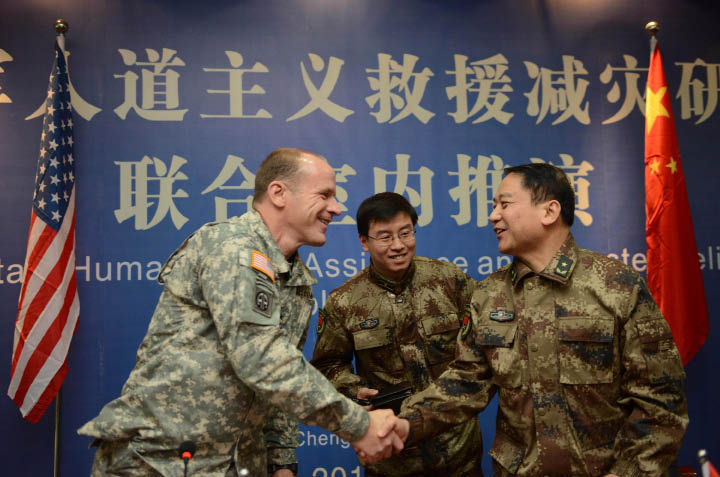New Great Power Relationship Strengthens China-U.S. Ties
Bilateral Military and Security Ties against a New Backdrop
As Hilary Clinton stated in an article published in Foreign Affairs, the United States is creating an American Pacific Age in the new century. Facing the rising political and economic significance of the Asia-Pacific region, the U.S. is fully aware that it is in danger of losing its global leadership role if it is absent from the region. With this reality in mind, the Obama administration has begun to cast its attention on the region, and exercise a so-called “rebalance” strategy.
In implementing this strategy, the U.S. has attempted to seek new alliances while consolidating its traditional ones. It has sought an increasingly active role in regional affairs by, for instance, intervening in such issues as the territoriality of the South China Sea and the Diaoyu Islands. The U.S.’s actions have stoked China’s concerns about its national security in the region.
In spite of this strategy of “rebalance,” China-U.S. military exchanges have seen sustained development. In May 2012, Liang Guanglie, Chinese Minister of National Defense, visited the U.S. – the first visit by a Chinese Minister of National Defense in nine years. In August, Cai Yingting, deputy chief of the General Staff of the People’s Liberation Army (PLA), also visited the U.S. In September, U.S. Defense Secretary Leon Panetta paid his first visit to China since taking on the post. In mid-December, Qi Jianguo, another deputy chief from the PLA General Staff, traveled to the U.S. as the head of a delegation to join James N. Miller, the U.S. Defense Under Secretary, in co-presiding over the 13th China-U.S. Defense Consultations. Besides high-level exchanges, the two sides have been engaged in exchanges on military systems and communications between colleges and research institutes. Plans are also in the works to carry out anti-piracy joint exercises. From November 29 to 30, 2012, a China-U.S. joint humanitarian assistance and disaster relief tabletop exercise was conducted in Chengdu, Sichuan Province.
Objectively speaking, it is inevitable that the U.S. strategy of “rebalancing” in the Asia-Pacific should aggravate bilateral military suspicions. Therefore, multi-level and multi-aspect bilateral military contact and interactions are necessary to help relieve military tensions between the two sides. Only when both are clued-in on their counterparts’ military and strategic intentions and capabilities can the leaderships make proper decisions that benefit the two countries and their peoples, and lower to zero the likelihood of military confrontation.
Booming Exchanges in Humanistic Sectors
Bilateral exchanges in humanistic sectors have played a critical role throughout the history of China-U.S. relations. The Ping Pong Diplomacy 40 years ago can be taken as an excellent example. In November 2009, state leaders of the two sides jointly made the decision to establish a high-level humanistic exchange consultation mechanism to strengthen communications and cooperation in a range of humanistic sectors such as education, science and technology, culture, women’s issues, youth and sport. The third China-U.S. high-level consultation on people-to-people exchanges kicked off in Beijing on May 3, 2012. Chinese State Councillor Liu Yandong and U.S. Secretary of State Hillary Clinton co-chaired the event.
According to official statistics, prior to the 2012 high-level consultation, 33 of the 41 proposals generated by the second round of the consultation had been implemented. For example, China’s programs to send 10,000 students to the U.S. for doctorate study and sponsor 10,000 Americans to study in China resulted in 4,000 Chinese students benefiting from the U.S. education system and financed 7,000 American students on the “Chinese Bridge” program. Meanwhile, the U.S. also made headway in its program to send 100,000 students to study in Chinese institutions. By May 2012, 23,000 students had come to China under the program.
On November 3, 2012, the inauguration ceremony of the China-U.S. Humanistic Exchange Research Base was held at Peking University. The base aims to carry out cross-cultural and interdisciplinary research. Since its establishment, it has been engaged in cooperative scientific research, academic exchanges and media coverage. Its operation helps to enhance mutual trust and friendship between the two countries’ peoples, eliminates prejudice and misunderstanding and promotes the healthy development of bilateral relations.
Humanistic exchanges alongside political trust and economic cooperation constitute the major pillars of China-U.S. relations.
 |
| The tabletop exercise of China-U.S. joint humanitarian assistance and disaster relief takes place on November 30 in Chengdu, Sichuan Province. |
Towards a New-type Great Power Relations
Barack Obama’s winning a second presidential term and the CPC successfully convening its 18th national congress signify a new era in China-U.S. relations. Throughout the evolutionary process of these relations, the two countries have never confronted such complicated tasks as they do today. In the past the two countries struggled to gain a balance between competition and cooperation, between challenges and opportunities, and between crises and stability. The question of how to maintain mutual respect and achieve mutual beneficial results in competition and cooperation will test the leadership on both sides of the Pacific. Perhaps, “seeking harmony in diversity” will become the principle by which the two countries achieve mutual respect and mutual benefit. On one hand, the two sides should expand their cooperation, stressing common benefits. On the other, they should also respect each other’s unique characteristics. Only in this way can the two countries peacefully co-exist.
For current China-U.S. ties, this new type of great power relationship has the potential to provide a proper framework for trends in future development marked by healthy competition, rather than confrontation.
Though tensions still exist between the two countries, such as those generated by the U.S.’s “rebalance” strategy in the Asia Pacific, their political consensus, mutual interests in economic cooperation and growing momentum in bilateral humanistic exchanges bespeak their interdependence.
The great power relationship refers to both countries and emphasizes that they should uphold international law and take on joint responsibilities in the world community.
By and large this means a strong America, but it also implies a new role for China as the other half of the great power relationship. China needs to adapt to its new role by learning from other countries, accumulating experiences, actively seeking a rebalance with its neighbors and ensuring that the benefits of its rise are felt across the globe.
DIAO DAMING is an assistant research fellow at the Institute of American Studies under the Chinese Academy of Social Sciences.
- Xi Elected Chinese President, Chairman of PRC Central Military Commission
- Li Keqiang Endorsed as Chinese Premier
- Fan Changlong, Xu Qiliang Endorsed as Vice Chairmen of Central Military Commission of PRC
- New Leadership Elected for China's Top Legislature
- Proceedings Initiated for China's Leadership Change

